Rear Compartment Floor Panel Sectioning
Danger: Always perform the High Voltage Disabling procedure prior to servicing any High Voltage component or connection. Personal Protection Equipment (PPE) and proper procedures must be followed.
The High Voltage Disabling procedure will perform the following tasks:
| • | Identify how to disable high voltage. |
| • | Identify how to test for the presence of high voltage. |
| • | Identify condition under which high voltage is always present and personal protection equipment (PPE) and proper procedures must be followed. |
| • | Safety glasses with appropriate side shields when within 15 meters (50 feet) of the vehicle, either indoors or outdoors. |
| • | Certified and up-to-date Class "0" Insulation gloves rated at 1000V with leather protectors. |
| - | Visually and functionally inspect the gloves before use. |
| - | Wear the Insulation gloves with leather protectors at all times when working with the high voltage battery assembly, whether the system is energised or not. |
Removal Procedure
Warning : Refer to Approved Equipment for Collision Repair Warning in the Preface section.
Warning : Sectioning should be performed only in the recommended areas. Failure to do so may compromise the structural integrity of the vehicle and cause personal injury if the vehicle is in a collision.
- Disable the SIR system. Refer to SIR Disabling and Enabling .
- Inspect the high voltage system. Refer to High Voltage System Inspection .
Note :
| • | The rear floor-pan service part comes as a pre-sectioned assembly. Make sure to follow these steps to prevent unnecessary repairs to the vehicle. |
| • | In areas where structural adhesive is present, use heat to facilitate removal of the components. |
- Remove all related panels and components.
- Remove the sealers and anti-corrosion materials from the repair area, as necessary. Refer to Anti-Corrosion Treatment and Repair .
- Repair as much of the damaged area as possible. Refer to Dimensions - Body .
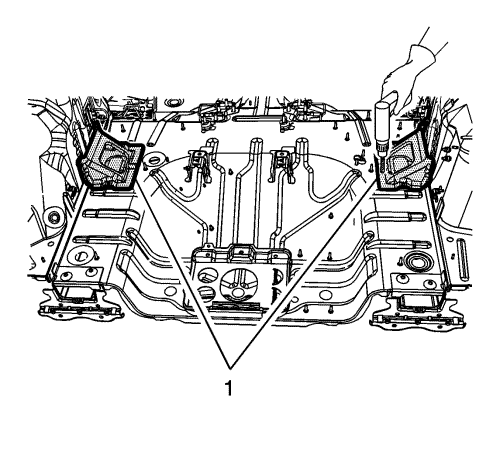
- Locate welds, drill and remove wheelhouse inner braces (1).

- Locate the rear edge of cross bar No. 5 (1) and inside edge of the frame rails (2) from under the vehicle.
- Drill several 1/8 in holes in the floor pan only along the rear edge of cross bar No. 5 and inside frame rails. This will help to identify the location from the top side of the floor pan.
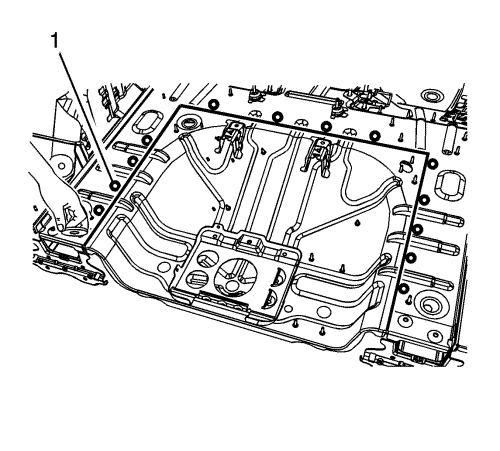
- Apply a piece of masking tape to the top surface of the rear compartment panel along the holes (1) drilled in the floor pan.
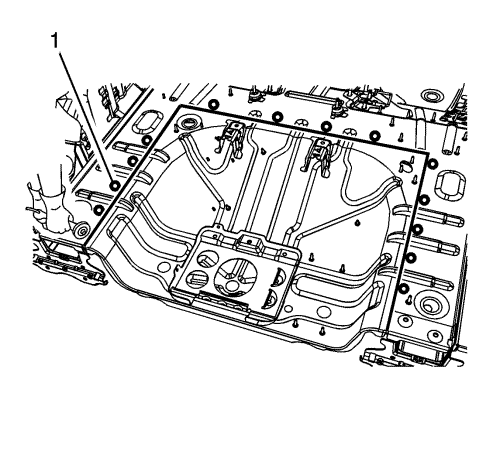
Note : Do not damage any adjacent panels or components when cutting or drilling out spot welds.
- Cut slightly rearward of the tape along the holes (1) drilled in the floor pan.
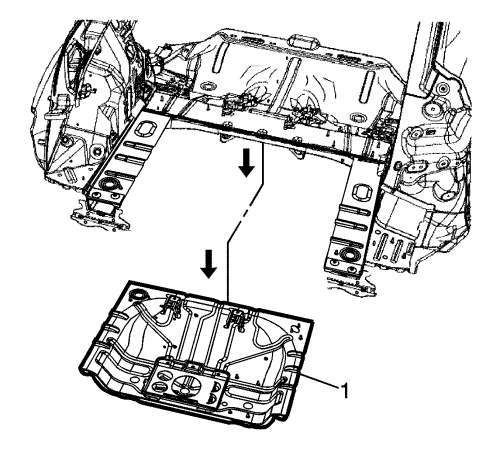
- Remove inner damaged portion of floor panel (1).

- Cut across remaining portion of floor (1).

- Chisel remaining portion (1) above frame rails and remove.
Installation Procedure
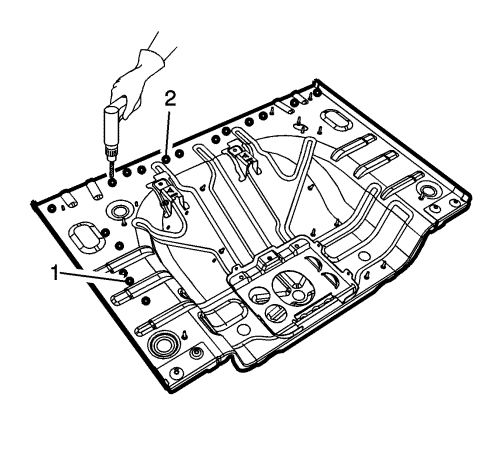
Note :
| • | If the location of the original plug weld holes cannot be determined, space the plug weld holes every 40 mm (1 ½ in) apart. |
| • | Some panels may have structural weld-thru adhesive. It is necessary to replace the weld-thru adhesive with an additional spot weld between each factory spot weld. |
- Drill 8 mm (5/16 in) plug weld holes (1) in the service part as necessary in the corresponding locations noted on the original panel.
- Lay out and drill an additional row (2) of 8 mm (5/16 in) plug weld holes on top of the no. 5 bar weld flanges.
- Prepare all mating surfaces for welding as necessary.
- Apply GM-approved Weld-Thru Coating or equivalent to all mating surfaces. Refer to Anti-Corrosion Treatment and Repair .
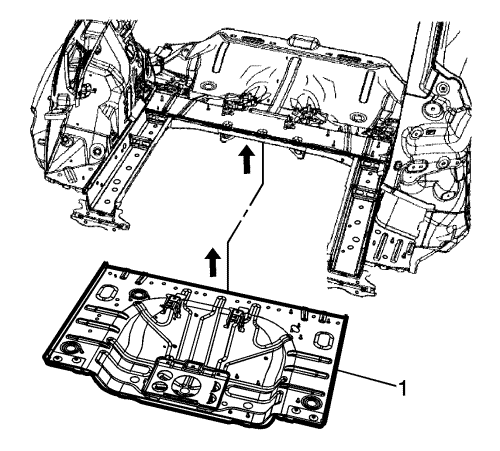
- Position the rear floor pan (1) to the vehicle using three-dimensional measuring equipment. Clamp the part in place.
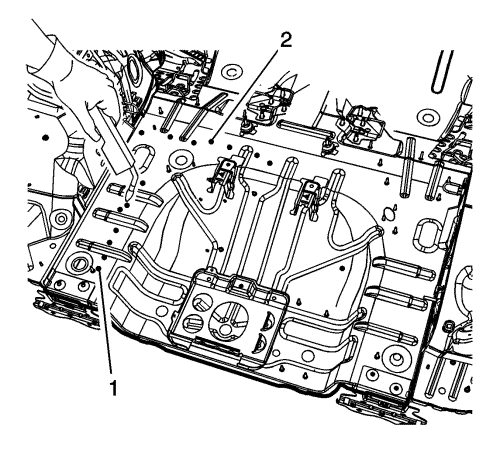
- Plug weld (1) accordingly.
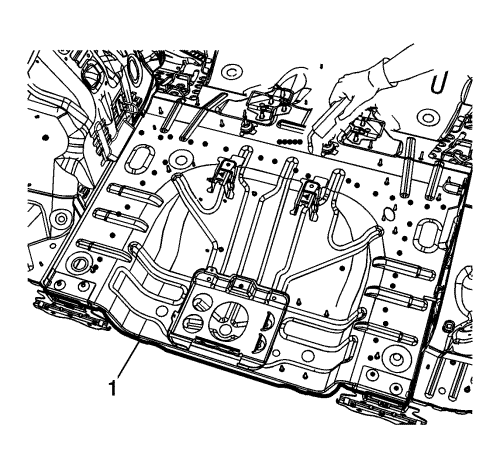
- Weld the seam (1) along the front cut edge of the floor panel service part. To create a solid weld along the front of the service part with a minimum of heat distortion, make a stitch weld along the seam with 25 mm (1 in) gaps between each weld.
- Clean and prepare all welded surfaces.
- Apply sound deadening materials as necessary.
- Paint the repaired area. Refer to Basecoat/Clearcoat Paint Systems .
- Apply the sealers and anti-corrosion materials to the repair area, as necessary. Refer to Anti-Corrosion Treatment and Repair .
- Install all related panels and components.
- If disabled, enable the high voltage system. Refer to High Voltage Enabling .
- Enable the SIR system. Refer to SIR Disabling and Enabling .
| ©© Copyright Chevrolet. All rights reserved |










